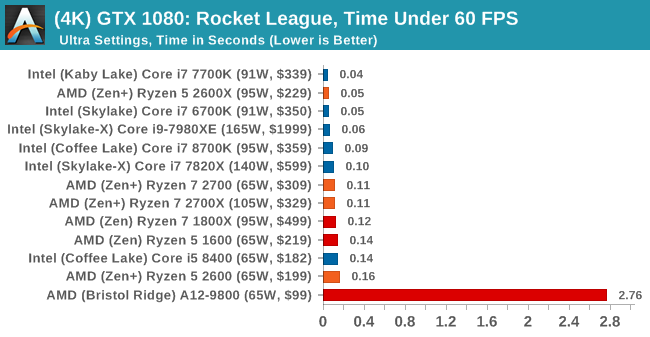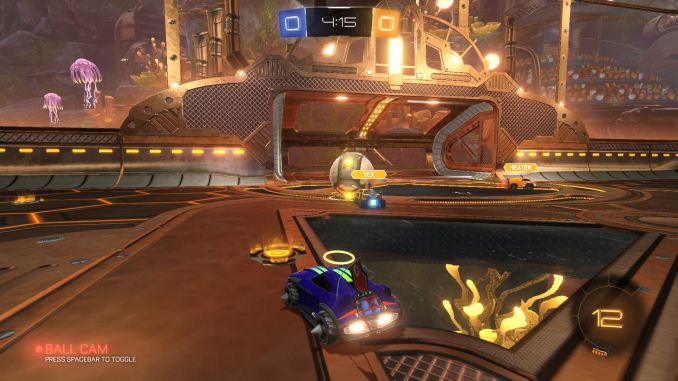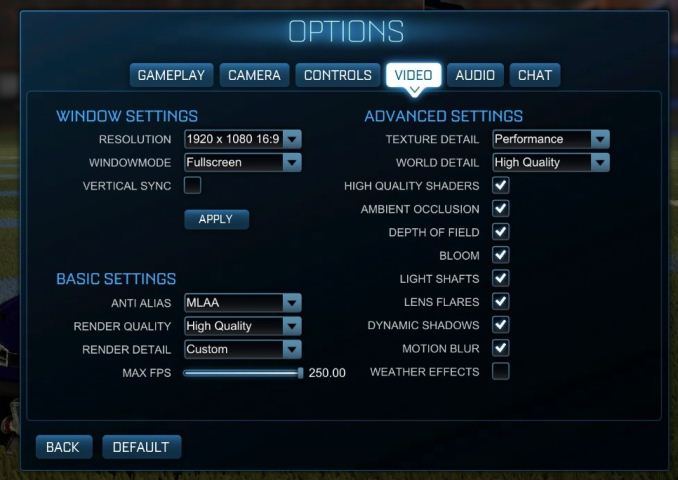The AMD 2nd Gen Ryzen Deep Dive: The 2700X, 2700, 2600X, and 2600 Tested
by Ian Cutress on April 19, 2018 9:00 AM ESTRocket League
Hilariously simple pick-up-and-play games are great fun. I'm a massive fan of the Katamari franchise for that reason — passing start on a controller and rolling around, picking up things to get bigger, is extremely simple. Until we get a PC version of Katamari that I can benchmark, we'll focus on Rocket League.
Rocket League combines the elements of pick-up-and-play, allowing users to jump into a game with other people (or bots) to play football with cars with zero rules. The title is built on Unreal Engine 3, which is somewhat old at this point, but it allows users to run the game on super-low-end systems while still taxing the big ones. Since the release in 2015, it has sold over 5 million copies and seems to be a fixture at LANs and game shows. Users who train get very serious, playing in teams and leagues with very few settings to configure, and everyone is on the same level. Rocket League is quickly becoming one of the favored titles for e-sports tournaments, especially when e-sports contests can be viewed directly from the game interface.
Based on these factors, plus the fact that it is an extremely fun title to load and play, we set out to find the best way to benchmark it. Unfortunately for the most part automatic benchmark modes for games are few and far between. Partly because of this, but also on the basis that it is built on the Unreal 3 engine, Rocket League does not have a benchmark mode. In this case, we have to develop a consistent run and record the frame rate.
Read our initial analysis on our Rocket League benchmark on low-end graphics here.
With Rocket League, there is no benchmark mode, so we have to perform a series of automated actions, similar to a racing game having a fixed number of laps. We take the following approach: Using Fraps to record the time taken to show each frame (and the overall frame rates), we use an automation tool to set up a consistent no-bot match on easy, with the system applying a series of inputs throughout the run, such as switching camera angles and driving around.
It turns out that this method is nicely indicative of a real match, driving up walls, boosting and even putting in the odd assist, save and/or goal, as weird as that sounds for an automated set of commands. To maintain consistency, the commands we apply are not random but time-fixed, and we also keep the map the same (Aquadome, known to be a tough map for GPUs due to water/transparency) and the car customization constant. We start recording just after a match starts, and record for 4 minutes of game time (think 5 laps of a DIRT: Rally benchmark), with average frame rates, 99th percentile and frame times all provided.
The graphics settings for Rocket League come in four broad, generic settings: Low, Medium, High and High FXAA. There are advanced settings in place for shadows and details; however, for these tests, we keep to the generic settings. For both 1920x1080 and 4K resolutions, we test at the High preset with an unlimited frame cap.
All of our benchmark results can also be found in our benchmark engine, Bench.
MSI GTX 1080 Gaming 8G Performance
1080p



4K
















545 Comments
View All Comments
Luckz - Monday, April 23, 2018 - link
PB2/XFR2 seems to be all the overclocking anyone would want to do on Ryzen 2xxx (besides LN2 and other non-sustainable things)werpu - Friday, April 20, 2018 - link
Ahem those initial results were meltdown only and January, there have been a boatload of fixes since then on both the meltdown and spectre side. So the data is not correct anymore. Even in January VMs etc.. everything I/O intensive already encountered a serious performance hit.Crazyeyeskillah - Friday, April 20, 2018 - link
Those reviews haven't rerun the intel chip parts, hence the dated data.Azix - Thursday, April 19, 2018 - link
They used a 1080 in these tests. maybe thats a factor5080 - Thursday, April 19, 2018 - link
I think what you're seeing with the other reviews is old database information being used without the spectre and meltdown patches. They only say that Ryzen+ was tested with the latest patches, but it dosn't say that they retested all the Intel systems with the BIOS fix and patches applied.Ryan Smith - Thursday, April 19, 2018 - link
All of our Intel systems were re-run with the full Smeltdown fixes for this review.wicketr - Thursday, April 19, 2018 - link
It's be interesting to have an article running all these tests pre and post patches to show how much they affect the system. There seems to be a lot of confusion about how bad it is.Ryan Smith - Thursday, April 19, 2018 - link
It's definitely something we're intending to mine from the data later, after we're over this launch hump.5080 - Thursday, April 19, 2018 - link
That's what I thought and what Chris113q doesn'r realize.hescominsoon - Thursday, April 19, 2018 - link
Chris,You need to take into account the latest system/bios patches for meltdown/spectre as well. Anandtech is not manipulating the results. Just because they get "different" results from "everybody else"(especially when you fail to cite the differences), strains your credibility.